The following people were bishops, prince-bishops or archbishops of Freising or Munich and Freising in Bavaria:
Contents
- Bishops of Freising
- Prince-bishops of Freising
- Archbishops of Munich and Freising
- See also
- References
- Sources
- External links

The following people were bishops, prince-bishops or archbishops of Freising or Munich and Freising in Bavaria:



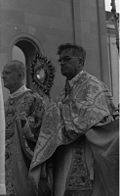
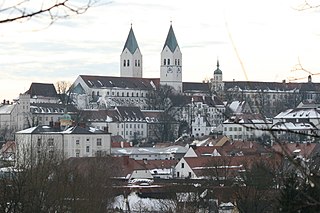
Freising is a university town in Bavaria, Germany, and the capital of the Freising Landkreis (district), with a population of about 50,000.

The Diocese of Passau is a Roman Catholic diocese in Germany that is a suffragan of the Archdiocese of Munich and Freising. Though similar in name to the Prince-Bishopric of Passau—an ecclesiastical principality that existed for centuries until it was secularized in 1803—the two are entirely different entities. The diocese covers an area of 5,442 km².

The Archdiocese of Munich and Freising is an ecclesiastical territory or diocese of the Roman Catholic Church in Bavaria, Germany. It is governed by the Archbishop of Munich and Freising, who administers the see from the co-cathedral in Munich, the Frauenkirche. The other, much older co-cathedral is Freising Cathedral.

Saint Corbinian was a Frankish bishop. After living as a hermit near Chartres for fourteen years, he made a pilgrimage to Rome. Pope Gregory II sent him to Bavaria. His opposition to the marriage of Duke Grimoald to his brother's widow, Biltrudis, caused Corbinian to go into exile for a time. His feast day is 8 September. The commemoration of the translation of his relics is 20 November.

The Diocese of Hildesheim is a diocese of the Catholic Church in Germany. Founded in 815 as a missionary diocese by King Louis the Pious, his son Louis the German appointed the famous former archbishop of Rheims, Ebbo, as bishop.
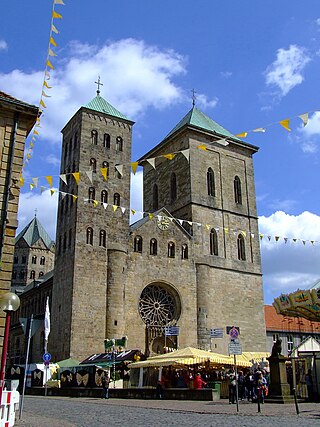
The Diocese of Osnabrück is a Latin Church ecclesiastical territory or diocese of the Catholic church in Germany. The diocese was originally founded circa 800. It should not be confused with the smaller Prince-Bishopric of Osnabrück–an ecclesiastical principality of the Holy Roman Empire until 1803–over which the bishop, as prince-bishop, exercised both temporal and spiritual authority.
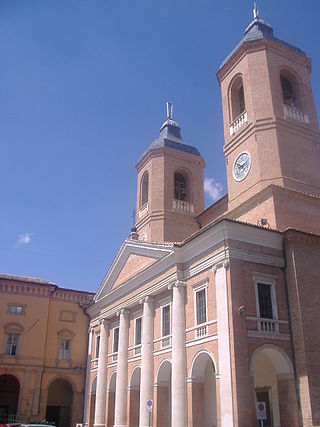
The Italian Archdiocese of Camerino-San Severino Marche is a Roman Catholic ecclesiastical territory, seated in Camerino, a city in the Province of Macerata, in the central Italian Marche region, in the Apennines. It is a suffragan of the Archdiocese of Fermo.

Freising Cathedral, also called Saint Mary and Corbinian Cathedral, is a romanesque basilica in Freising, Bavaria. It is the co-cathedral of the Catholic Archdiocese of Munich and Freising. Freising Cathedral is also known for being the place where Pope Benedict XVI was ordained a priest.

The Diocese of Belley–Ars is a Latin Church ecclesiastical jurisdiction or diocese of the Catholic Church in France. Erected in the 5th century, the diocese was renamed in 1988 from the former Diocese of Belley to the Diocese of Belley–Ars. Coextensive with the civil department of Ain, in the Region of Rhône-Alpes, the diocese is a suffragan see of the Archdiocese of Lyon. The cathedra of the bishop is at Belley Cathedral. The current bishop is Guy Claude Bagnard, appointed in 1987.

The Diocese of Regensburg is a Roman Catholic ecclesiastical territory seated in Regensburg, Germany. Its district covers parts of northeastern Bavaria; it is subordinate to the archbishop of Munich and Freising. As of 2014, the diocese had 1.20 million Catholics, constituting 70% of its total population. The current bishop is Rudolf Voderholzer. The main diocesan church is Saint Peter in Regensburg. The diocese is divided into eight regions and 33 deaneries with 769 parishes. It covers an area of 14,665 km2.

The Diocese of Münster is an ecclesiastical territory or diocese of the Catholic Church in Germany. It is a suffragan diocese of the Archdiocese of Cologne. Bishop Felix Genn is the current bishop of the Diocese of Münster. He was ordained to the priesthood on 11 July 1976 and was appointed to the See of Münster on 19 December 2008.

The Italian Catholic Archdiocese of Perugia-Città della Pieve was historically the Diocese of Perugia. It became the Archdiocese of Perugia in 1882, but without suffragans. It acquired suffragan dioceses in 1972. It was united in 1986 with the Diocese of Città della Pieve.

The Roman Catholic Archdiocese of Salzburg is an archdiocese of the Latin Church of the Roman Catholic Church in Austria. The archdiocese is one of two Austrian archdioceses, serving alongside the Archdiocese of Vienna.
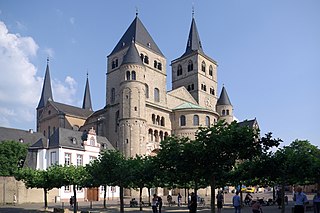
The Diocese of Trier, in English historically also known as Treves from French Trèves, is a Latin Church ecclesiastical territory or diocese of the Catholic church in Germany. When it was the archbishopric and Electorate of Trier, it was one of the most important states of the Holy Roman Empire, both as an ecclesiastical principality and as a diocese of the church. Unlike the other Rhenish dioceses—including Mainz and Cologne–Trier was the former Roman provincial capital of Augusta Treverorum. Given its status, Trier has continuously been an episcopal see since Roman times and is one of the oldest dioceses in all of Germany. The diocese was elevated to an archdiocese in the time of Charlemagne and was the metropolitan for the dioceses of Metz, Toul, and Verdun. After the victory of Napoleon Bonaparte of France, the archdiocese was lowered to a diocese and is now a suffragan in the ecclesiastical province of the Archdiocese of Cologne. The diocesan cathedral is the Cathedral of Saint Peter. The Cathedral Chapter retains the right to elect the bishop, rather than selection by papal appointment.
Bishops of the Wrocław Bishopric, Prince-Bishopric (1290–1918), and Archdiocese.
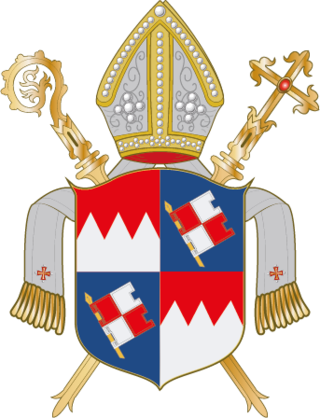
The Diocese of Würzburg is a diocese of Catholic Church in Germany. The diocese is located in Lower Franconia, around the city of Würzburg, and the bishop is seated at Würzburg Cathedral. Founded in 741, the diocese lost all temporal power after the Napoleonic wars.

The Italian Roman Catholic Diocese of Trieste in the Triveneto, has existed since no later than 524, and in its current form since 1977. The bishop's seat is in the Cathedral Basilica of Saint Justus Martyr. It is a suffragan of the Archdiocese of Gorizia.

The Roman Catholic Archdiocese of Nueva Pamplona is an archdiocese located in the city of Nueva Pamplona in Colombia.
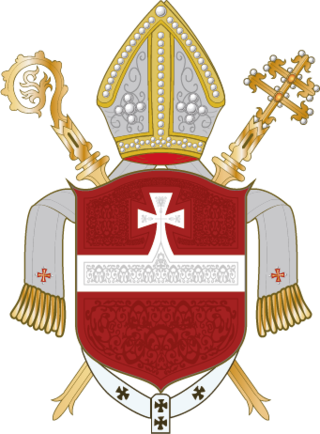
The Roman Catholic Archdiocese of Vienna is an archdiocese of the Catholic Church in Austria. It was erected as the Diocese of Vienna on 18 January 1469 out of the Diocese of Passau, and elevated to an archdiocese on 1 June 1722. The episcopal see resides in the cathedral of Stephansdom in Vienna. The current bishop is Christoph Schoenborn, appointed in 1995 and elevated to cardinal in 1998.

The Prince-Bishopric of Freising was an ecclesiastical principality of the Holy Roman Empire from 1294 until its secularisation in the early years of the 19th century.